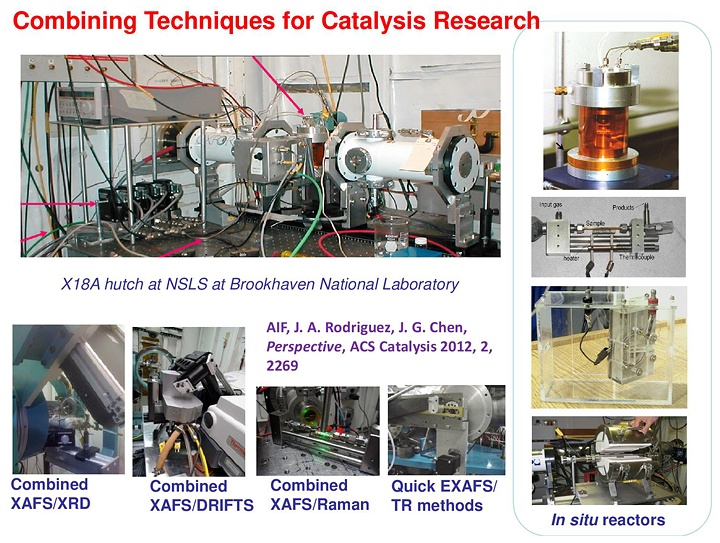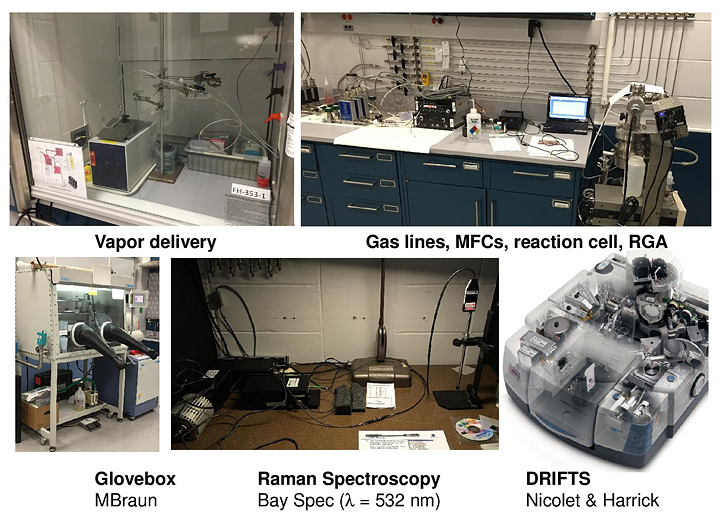- Home
-
Research Groups
Division Groups
- Artificial Photosynthesis
- Catalysis: Reactivity & Structure
- Electrochemical Energy Storage
- Electron- and Photo-Induced Processes for Molecular Energy Conversion
- Neutrino and Nuclear Chemistry
- Surface Electrochemistry and Electrocatalysis
Associated Groups
- Catalysis for Alternative Fuels Production
- Nanostructured Interfaces for Catalysis
- Structure and Dynamics of Applied Nanomaterials
- People
- Operations
- News
- Events

Structure and Dynamics of Applied Nanomaterials
The SDAN Group at BNL develops experimental techniques, data collection, analysis and modeling methods for understanding mechanisms of work of applied nanomaterials. Our philosophy is to investigate atomic and electronic structure and dynamics in active state, and link these properties to function by monitoring materials at work, i.e., in operando conditions.
We use different probes, e.g. synchrotron X-ray (absorption, emission, and scattering), vibrational spectroscopies (Raman and Infrared) and electron (imaging, spectroscopy and scattering), all used in combination with reaction product analysis (e.g., MS or GC). We integrate complementary methods, including first principles theory, in a suit of techniques for capturing relevant descriptors of activity concurrently, in the same active state of the working nanomaterial.

Group Instrumentation (BNL Chemistry lab)
Sample preparation:
Glovebox: MBRAUN
Nano-hood with HEPA filter (Flow Science, Inc),balance, ultrasonic cleanser (Branson 1510), stir & heat plate, centrifuge (IEC Centra CL2), hydraulic press (Carver, Inc: Model 4350.L, 13mm diets).For reaction studies:
We have two sets of gas input/output systems and several types of reactors for catalytic reaction studies. One gas input system has four gas lines (controlled by mass flow controllers) and designed for macro reactors. Macro reactors include a Nashner-Adler reaction cell (Kapton foil sealed cylinder, for pellet samples) and a Clausen Cell reactor (tube reactor, powder samples). Both reactors can be used for high temperature measurements (connected to temperature controllers and power supplies) and are applicable for most of the synchrotron based techniques.The other gas manifold is dedicated for work with Hummingbird Scientific micro-reactor. It can be used for both spectroscopic (with micro beam) and microscopic techniques, and can work at high temperatures (up to 500°C) and pressures (up to 1 atom.). A residual gas analyzer, RGA (SRS RGA 200), is connected to reactors for detecting the mass of gas molecules.
We have several liquid cells with different thickness for in-situ measurements including particle growth and diffusion. They were designed for synchrotron based techniques including X-ray absorption and X-ray diffraction.
-
A Raman spectrometer (532nm, ANSI Class: 3B) with external probe, compatible with Clausen cell reactor (a quartz capillary) for in situ/operando reaction studies.
A DRIFTS instrument: Nicolet spectrometer with Harrick reactor cell, for in situ/operando reaction studies

BNL Facilities
- Electron Microscopy Facility at Center for Functional Nanomaterials (CFN): HAADF-STEM, HRTEM, E-TEM, EELS
Other User Facilities
- National Synchrotron Light Source II (NSLS II-BNL)
- Electron Microscopy Facility at Center for Functional Nanomaterials (CFN): HAADF-STEM, HRTEM, E-TEM, EELS
- Advanced Photon Source (APS-ANL)
- Beamline 10BM-A,B, 5-BM-D and 9BM-B,C : XAFS for Operando catalysis
- Beamline 17-BM-B: Powder diffraction for catalysis
- Advanced Light Source (ALS-LBNL)
- Beamline 1.4: Infrared spectromicroscopy for investigation of nanocatalysts in micro-reactor
- Swiss Light Source (SLS-PSI)
- Beamline X10DA (SuperXAS): EXAFS, High energy resolution XANES, XES and RIXS for studies of nanocatalysts in operando conditions
- Stanford Synchrotron Radiation Lightsource (SSRL-SLAC)
- Beamline 2-2: XAFS for a wide range of functional nanomaterials
- Beamline 6-2b: High energy resolution XANES, RIXS and XES for functional materials
Software for Data Analysis and Simulations
- IFEFFIT and Demeter: for XAFS data processing and analysis
- FEFF6,8,9: ab initio multiple scattering calculations of XAFS, XANES and other spectra
- Digital Micrograph and Tecnai Image Analysis (TIA) for imaging, particle counting, elemental and composition analysis
- GSAS-II and Jana2006 for diffraction data analysis




